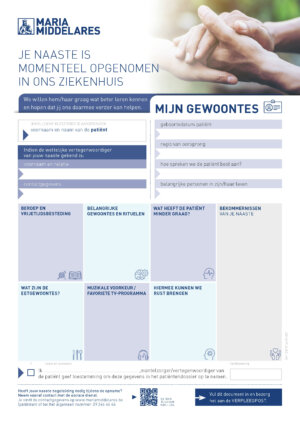Week of the Patient: a number of patient-focused initiatives
On the occasion of the week of the patient (17 - 21 October) and the action 'You have more to tell each other than you think' of non-profit organisation Patient Empowerment (10/25) , we are highlighting some of the initiatives we are using to continue to improve communication between our staff, patients, visitors and physicians.
First Aid with Communication (EHBC) box
First Aid with Communication (EHBC) box

First Aid with Communication, or the EHBC box, gives patients with communication and language problems a voice. A box is also placed with patients who have mild or more severe dementia. The First Aid with Communication (EHBC) box is a toolkit with aids that support communication (e.g. pictogrammes, yes/no boards, alphabet card), all of which the hospital available in multiple copies.
The goal is to enhance patient empowerment and to give care professionals an accessible way to easily speak with the patient. Patients may simply and clearly indicate their needs and reduce speech confusion to a minimum.
My habits
My habits
Do you care for someone with a cognitive disorder or dementia, and is a hospital admission scheduled? Help us to get you know your loved one, so we can take their daily routines into account as best as possible during their hospital stay. This will ensure a calmer and more comfortable hospital stay.
See here for more detailed information on dementia.
You can find the document below. Print it out, complete it and return it to the nurse in the department (nursing desk). The document will be put up in the room.
Only available in Dutch:

Mijn gewoontes
Download
Pictoindicator
PictoindicatorIn the First Aid with Communication (EHBC) box, you will find, among other things, a pictoindicator that is thematically prepared (e.g. hygiene, toilet use, mobility, etc.). The patient may use the indicator to make his needs or questions known, for example:
- ‘Could you please open/close the door?’
- ‘How late is it?’
- ‘I would like to sit in the chair.’
- ‘I feel nauseous.’
Collaborations with patient associations
Collaborations with patient associationsOur hospital works together closely with a large number of patient associations and self-help groups. Cohorts in these groups can be a tremendous support for patients (or those close to the patient). Exchanging all sorts of tips and experiences helps you cope better with a certain illness or condition.
An overview of these collaborations is provided here.
Interpreters
InterpretersDo you speak another language or are you deaf or hard of hearing? Then you can let an interpreter assist you. See here for more detailed information.

Visual sandwich buffet cart
Visual sandwich buffet cartThe sandwich buffet carts in the hospital are outfitted with a visual menu card. It is an alternative to the written menu that every patient has on his/her bedside table, and is primarily used for patients who have communicative or cognitive difficulties (e.g. patients with dementia or patients who have suffered a brain bleed). Using the corresponding photos, the patient can independently indicate what he/she would like to eat or drink. The menu card is organised by food groups.
Reading-out-loud function on our website
Reading-out-loud function on our websiteDid you notice it at the top of this page? Our website has its own voice! On every page of our website, you will find a text-to-speech function. This function allows you to listen to an audio version while you follow the highlighted text. It is a useful function for people who have problems with reading, for example, or who have a visual impairment or who are learning Dutch.
Do the standard settings not meet your expectations? Then you can simply use the menu to adjust the reading speed and the colours. You can also select a web page in order to listen to it, and so that you do not have to start from the beginning.
Something wrong or unclear on this page? Report it.



